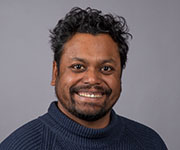Dr.-Ing. Gargi Nayak

Dr. -Ing. Gargi Shankar Nayak
wissenschaftlicher Projektkoordinator

wissenschaftlicher Projektkoordinator
The reports from the World Health Organisation (WHO) makes it clear that injuries are one of the substantial causes of morbidity and mortality all around the world [1]. The majority of the injuries are too complex to be healed naturally and often require fixation through implants via surgery. However, the complexity of a human body always makes it challenging for any implant to perform coequal to the native body part. Thus, in-depth research is required for the development of implants that can help in retaining the functionality of the body part with minimal side effects to fulfil the dire needs of the present and the future. Taking this into consideration, this group will focus on developing these novel implants along with performing studies to investigate their potential in realistic scenarios.
With the help of biomechanics (studying the mechanical aspects of the biological systems) a realistic scenario can be created for the investigation of the implants. These studies involve understanding the loading scenarios for the defective body part under investigation, the structure of that part and the best possible scenario needed for healing to occur at that part. This can help in determining the adequate mechanical properties required for the implant along with the adequate shape (functional graded, pore size etc.) of the implant and the best fixation strategy needed to fulfil the needs of the defective part. This can help in developing a patient-specific solution strategy for implants development. In the case of biodegradable implants these studies are even more important, as the biodegradation of the implant should have a coherence with the healing of the defect, to withhold the functionality of the defected body part throughout the healing process. For this purpose, new experimental setups will be designed, and computational studies will be performed.
On the other hand, development of new implants requires implementation of new technologies. Even if the desired properties needed for the implant is known, without the development of these new pathways such implants cannot be realized. Thus, the other section of this group will be to find the novel techniques to develop the adequate implants. For this purpose, thorough research work will be performed in the field of additive manufacturing, biomineralization, surface modification strategies etc. to develop new implants, as well as to add new functionalities to the currently used implants.
Reference
[1] J. A. Haagsma et al., “The global burden of injury: Incidence, mortality, disability-adjusted life years and time trends from the global burden of disease study 2013,” Injury Prevention, vol. 22, no. 1, pp. 3–18, Feb. 2016, doi: 10.1136/injuryprev-2015-041616.
https://orcid.org/0009-0006-4806-1488
Ongoing research fields and partners
Project aim: To develop implants whose stiffness can be controlled to promote enhanced bone healing.
|
|
Project aim: To develop patient-specific dental peri-implant bone healing model using FEM and AI based surrogate model.
|
|
|
|
|
|
|